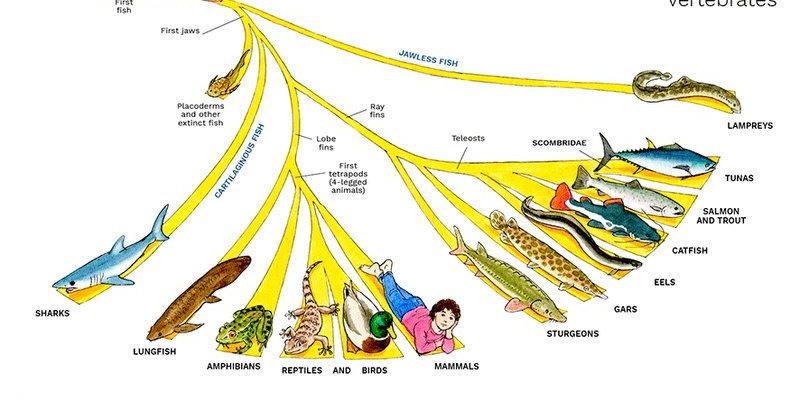
Tuna belong to the family Scombridae and have evolved to be some of the most successful fish in the ocean. Picture a time when their ancestors were quite different—more like tiny fish darting through the water. As we explore their evolutionary path, from ancient relatives to the modern-day marvels, you’ll find that the ocean has shaped them into streamlined hunters with unique adaptations. So grab your metaphorical diving gear, and let’s start this journey!
The Ancient Ancestors of Tuna
To understand tuna, we need to go way back in time. The earliest relatives of tuna can be traced to a group of fish called the Scombriformes, which existed around 50 million years ago. Imagine a bustling underwater world where fish were beginning to evolve into more specialized forms. Unlike their ancient ancestors, who had a slower, less efficient means of swimming, these early Scombrids began developing characteristics that would help them thrive in the ocean’s competitive environment.
These early fish had a torpedo-shaped body that allowed them to swim faster. They were small, agile, and capable of great bursts of speed. Over time, natural selection favored those fish that could swim swiftly to escape predators and catch prey. This evolutionary pressure led to the emergence of what we now recognize as the tuna—fierce, fast, and incredibly streamlined.
The Birth of Modern Tuna Species
The journey of tuna really kicked into high gear about 30 million years ago. During this time, several distinct species evolved, each adapting to different environments and prey types. From the Bluefin Tuna to the Yellowfin Tuna, these species developed unique traits that made them suited for their specific niches in the ocean.
For instance, the Bluefin Tuna became known for its massive size and remarkable ability to swim at high speeds. On the other hand, the Yellowfin Tuna evolved to be more agile and prefer warmer waters. Each tuna species adapted not just for survival but also for thriving within their ecosystems, showcasing nature’s incredible adaptability.
Why Tuna Are Such Fast Swimmers
You might be wondering, what makes tuna so fast in the water? Here’s the thing: it all comes down to their incredible body structure and active hunting strategies. Tuna have a streamlined body, which reduces drag as they swim. This design is like an arrow cutting through the water, allowing them to reach speeds of up to 75 miles per hour!
Additionally, tuna possess a unique feature called the tuna blood flow system. They can maintain their body temperature, thanks to their special blood vessels, which helps them swim faster. This adaptation is known as regional endothermy, allowing them to thrive in cooler waters while maintaining high energy levels. Combined with their powerful muscles, fish like the Bluefin Tuna are built for speed, making them top predators in the ocean.
The Role of Migration in Tuna Evolution
Migration plays a critical role in the life cycles of tuna. Many species travel vast distances across oceans, often migrating thousands of miles to find spawning grounds and feeding areas. This journey isn’t just about searching for food; it also shapes their evolutionary development.
For example, tuna that migrate to different environments encounter various challenges, from changing water temperatures to the availability of prey. These conditions push them to adapt. Those that can swim longer distances and adapt to different habitats are more likely to survive and pass on their genes. This migratory behavior has created strong population structures, allowing essential genetic diversity among tuna species.
The Impact of Human Activity on Tuna Evolution
As tuna have evolved, human beings have entered the picture, significantly impacting their populations and habitats. Overfishing, pollution, and habitat destruction are just a few of the threats these fish face today. The quest for tuna, particularly for prized species like the Bluefin, has led to dramatic declines in their numbers.
With the demand for sushi and other tuna products high, it’s crucial to recognize how our actions affect their evolution. Overfishing can disrupt the balance of the ecosystem and diminish genetic diversity, which is vital for their long-term survival. Conservation efforts are now more critical than ever to ensure future generations can witness these magnificent fish.
Conservation and Future of Tuna
Conservation strategies are essential to protect tuna populations and their habitats. Many organizations are working tirelessly to promote sustainable fishing practices and to raise awareness about the importance of tuna in marine ecosystems. These efforts include implementing fishing quotas, establishing marine protected areas, and promoting aquaculture as an alternative to wild fishing.
Additionally, innovations in technology are helping researchers track tuna populations better. By understanding their behaviors and habitats, scientists can develop more effective conservation strategies. The future of tuna depends not only on understanding their evolutionary journey but also on our commitment to preserving their environment for generations to come.
The Fascinating Legacy of Tuna
In the grand scheme of the ocean’s narrative, tuna hold a special place. Their evolutionary journey is a testament to adaptability and resilience, showcasing how species can thrive despite challenges. Each species tells a story of survival, speed, and grace. As we deepen our understanding of these fish, we gain insight into the broader health of the oceans and the delicate balance of marine life.
Ultimately, preserving tuna means also protecting the rich tapestry of the ocean’s ecosystems. As we continue to explore their evolutionary journey, let’s commit to ensuring these amazing fish can swim and thrive in our oceans for many years to come. The story of tuna is still being written, and with a little effort, we can ensure it’s a tale of success and sustainability.

